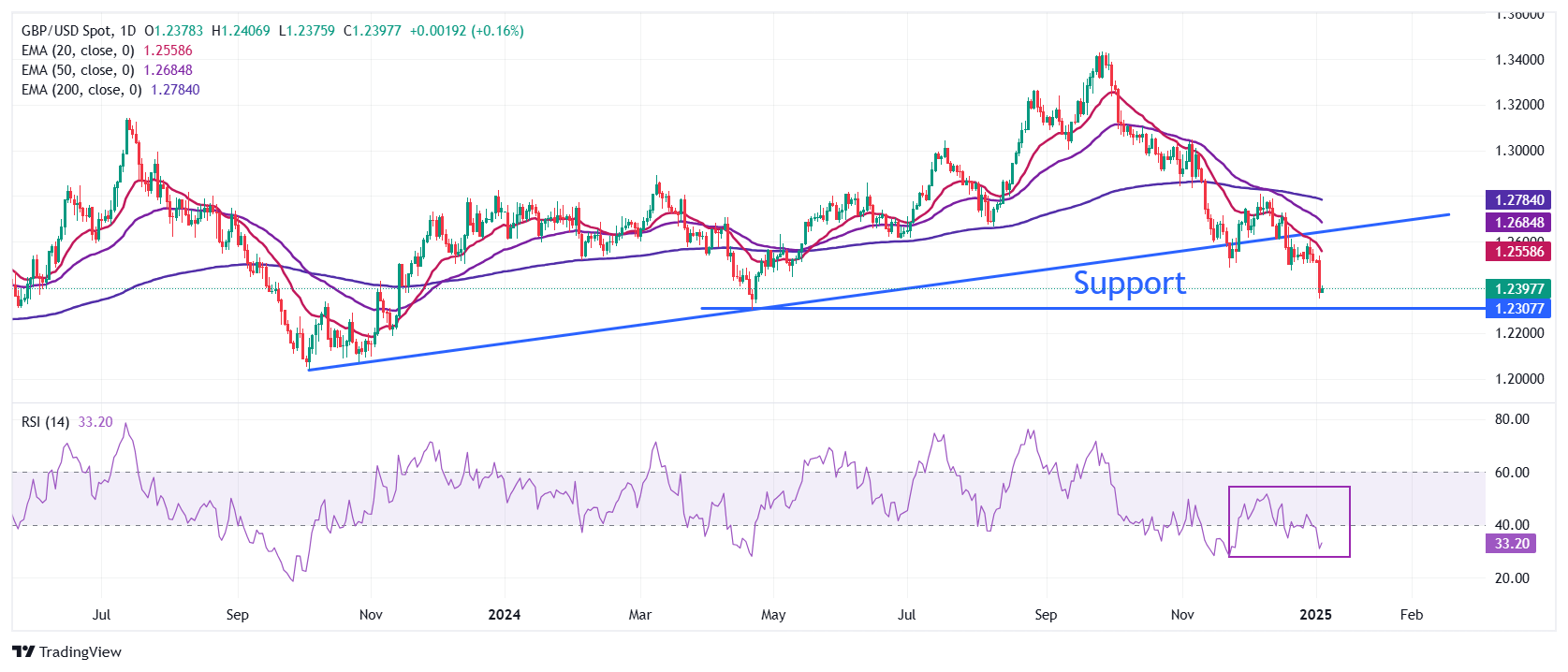Pound Sterling faces pressure against USD as investors assess US economic outlook
- The Pound Sterling seems vulnerable near 1.2400 against the US Dollar as the Fed has signaled fewer interest rate cuts this year.
- Lower US Initial Jobless Claims have signaled an improvement in labor market conditions.
- The BoE is expected to cut interest rates by 60 bps this year.
The Pound Sterling (GBP) trades near a more-than-eight-month low around 1.2400 against the US Dollar (USD) in Friday’s European session. The GBP/USD pair is under pressure while the US Dollar has extended its bull run as market participants expect fewer interest rate cuts from the Federal Reserve this year.
The latest dot plot at the Fed's Summary of Economic Projections showed that policymakers collectively see Federal Fund rates heading to 3.9% by the end of 2025, higher than the 3.4% forecasted in September.
The US Dollar Index (DXY), which tracks the Greenback’s value against six major currencies, trades nearly a fresh two-year high above 109.00 recorded on Thursday. The positive move was backed partly by lower United States (US) Initial Jobless Claims and optimism about the economic outlook from the incoming policies, such as tighter immigration, higher import tariffs, and lower taxes, under the administration of President-elect Donald Trump.
The number of individuals applying for initial jobless benefits was 211K for the week ending December 27, the lowest in eight months, which indicates a healthy labor market.
In Friday’s session, investors will focus on the US ISM Manufacturing Purchasing Managers Index (PMI) data for December, which will be published at 15:00 GMT. Economists expect the PMI to remain unchanged at 48.4, suggesting that activity in the manufacturing sector contracted at a steady pace.
Daily digest market movers: Pound Sterling trades with caution on slight acceleration in BoE dovish bets
- The Pound Sterling trades cautiously against its major peers on Friday and faces pressure from weak United Kingdom (UK) S&P Global/CIPS Manufacturing PMI data for December. On Thursday, the final PMI report showed that activity in the manufacturing sector contracted at a faster pace to 47.0 compared to the preliminary reading of 47.3. The report showed that the downturn was widespread in nature, with similarly sharp rates of decline across the consumer, intermediate, and investment goods industries.
- Rob Dobson, Director at S&P Global Market Intelligence said, "Business sentiment is now at its lowest for two years, as the new Government's rhetoric and announced policy changes dampen confidence and raise costs at UK factories and their clients alike. SMEs are being especially hard hit during the latest downturn."
- Meanwhile, rising Bank of England (BoE) dovish bets have also bruised the Pound Sterling. Traders price in roughly 60 basis points (bps) interest rate reduction by the BoE this year, up from 53 bps recorded in the last week of December.
Technical Analysis: Pound Sterling stays bearish as all short-to-long EMAs slope downwards

The Pound Sterling plunged below 1.2400 against the US Dollar on Thursday. The outlook of the GBP/USD pair was already vulnerable as the pair trades below the upward-sloping trendline around 1.2600, which is plotted from the October 2023 low of 1.2035.
All short-to-long-term Exponential Moving Averages (EMAs) are sloping down, suggesting a strong bearish trend in the long run.
The 14-day Relative Strength Index (RSI) oscillates below 40.00, signaling a strong downside momentum.
Looking down, the pair is expected to find a cushion near the April 22 low at around 1.2300. On the upside, the psychological level of 1.2500 will act as key resistance.
Pound Sterling FAQs
The Pound Sterling (GBP) is the oldest currency in the world (886 AD) and the official currency of the United Kingdom. It is the fourth most traded unit for foreign exchange (FX) in the world, accounting for 12% of all transactions, averaging $630 billion a day, according to 2022 data. Its key trading pairs are GBP/USD, also known as ‘Cable’, which accounts for 11% of FX, GBP/JPY, or the ‘Dragon’ as it is known by traders (3%), and EUR/GBP (2%). The Pound Sterling is issued by the Bank of England (BoE).
The single most important factor influencing the value of the Pound Sterling is monetary policy decided by the Bank of England. The BoE bases its decisions on whether it has achieved its primary goal of “price stability” – a steady inflation rate of around 2%. Its primary tool for achieving this is the adjustment of interest rates. When inflation is too high, the BoE will try to rein it in by raising interest rates, making it more expensive for people and businesses to access credit. This is generally positive for GBP, as higher interest rates make the UK a more attractive place for global investors to park their money. When inflation falls too low it is a sign economic growth is slowing. In this scenario, the BoE will consider lowering interest rates to cheapen credit so businesses will borrow more to invest in growth-generating projects.
Data releases gauge the health of the economy and can impact the value of the Pound Sterling. Indicators such as GDP, Manufacturing and Services PMIs, and employment can all influence the direction of the GBP. A strong economy is good for Sterling. Not only does it attract more foreign investment but it may encourage the BoE to put up interest rates, which will directly strengthen GBP. Otherwise, if economic data is weak, the Pound Sterling is likely to fall.
Another significant data release for the Pound Sterling is the Trade Balance. This indicator measures the difference between what a country earns from its exports and what it spends on imports over a given period. If a country produces highly sought-after exports, its currency will benefit purely from the extra demand created from foreign buyers seeking to purchase these goods. Therefore, a positive net Trade Balance strengthens a currency and vice versa for a negative balance.


